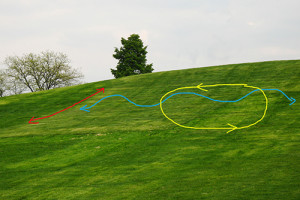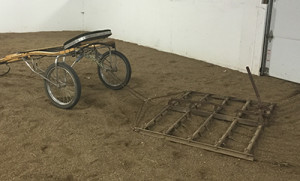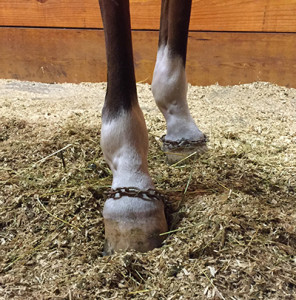A strong hind end is necessary for a good performing horse in any discipline, but especially so in Saddle Seat. We like to see a horse with “good hocks,” which refers to the horse’s ability to use his hind end to its fullest range of motion height-wise. The ideal hind end will have high, snapping hocks combined with plenty of impulsion. The video below of WGC Nutcracker’s Nirvana demonstrates both a great range of motion and great impulsion coming from the hind end.
https://youtu.be/SKXjMjOj4zU
As exhibitors, we tend to be most impressed by the horses with high stepping hocks, but if the horse isn’t also pushing itself forward with a nice spring in their step the way Nirvana does, they will look strung out and disunited. While it’s tempting to play with shoeing as a quick fix, that doesn’t usually work for the hind end. Shoeing will affect timing more than motion when it comes to the hind end, as motion comes from a combination of conformation, conditioning, and collection/impulsion. I believe conformation plays the biggest role in how a horse will move behind, followed by collection and impulsion. But collection and impulsion are not possible without conditioning, so I’m going to talk about some things you can do to help your horse get stronger so it’s easier for them.
Very simply put, the height of a horse’s hind end motion comes from the muscles that pull the leg forward and the hoof upwards, while the loft and spring comes from the muscles that propel the horse forward, so I bucket the work into “pushing” and “pulling” exercises. To me, pushing work is anything that propels the horse forward and focuses more on the muscles on the back of the legs, back, and top of the croup, while pulling work lifts the leg and focuses more on the muscles on the front of the leg and the abs. However, all of the muscles work together, so none of these exercises will isolate a muscle group, but they will provide a good hind end workout that will result in a stronger overall horse with greater range of motion.
I try to provide a balance of work throughout the week so I’m not focusing on one area to the detriment of another. And I vary up the routine within every workout to prevent overly fatiguing the horse or causing mental stress or boredom.
Pushing Work
 Strength Training: Just building muscle in general will help, as a weak horse cannot possibly use itself to its fullest potential, at least not for very long. Two of my favorite strengthening exercises are hill work and dragging. I find more improvement when I do these exercises at a slow jog instead of a faster show trot or canter, although it is good to include faster gaits within the workout as well.
Strength Training: Just building muscle in general will help, as a weak horse cannot possibly use itself to its fullest potential, at least not for very long. Two of my favorite strengthening exercises are hill work and dragging. I find more improvement when I do these exercises at a slow jog instead of a faster show trot or canter, although it is good to include faster gaits within the workout as well.
For hill work, I like to use a long, low grade instead of a steeper hill. I will trot the horse up and down the hill, and also do serpentines across the width of the hill. Sometimes I’ll long line on the hill, so the horse has to quickly transition itself from up to sideways to down to sideways to back up again. This really helps them with body awareness and balance. (Click the image to enlarge.) I always put protective gear on my horse whenever I’m doing hill work, especially if the horse is new to it, since they are more likely to strike themselves with a wayward hoof.
 For dragging, I hook a harrow or ring drag to my jog cart. This can be a VERY strenuous workout, particularly if the footing is wet or deep, so start slow. For a horse new to this, I will start with them just walking once around each way and then unhook the drag. Over a period of months, I’ll gradually build up the horse to where they can trot 4-5 times around each direction, with a few walking rounds in there as a break, before I unhook the drag (I never use it for the entire workout). I generally drive my horse 2-3 times a week, and usually one of those times is with the drag. I don’t want to overdo it, and I like to work on other things the other days I’m driving. Also, I always unhook the drag and end with an “easy” trot so the horse doesn’t get sour on driving.
For dragging, I hook a harrow or ring drag to my jog cart. This can be a VERY strenuous workout, particularly if the footing is wet or deep, so start slow. For a horse new to this, I will start with them just walking once around each way and then unhook the drag. Over a period of months, I’ll gradually build up the horse to where they can trot 4-5 times around each direction, with a few walking rounds in there as a break, before I unhook the drag (I never use it for the entire workout). I generally drive my horse 2-3 times a week, and usually one of those times is with the drag. I don’t want to overdo it, and I like to work on other things the other days I’m driving. Also, I always unhook the drag and end with an “easy” trot so the horse doesn’t get sour on driving.
Bounce Walk: I usually do this in long lines, but you can do it riding or driving, too. It’s not a western jog, and it’s not a medium trot. You want your horse to have major engagement, with the hind legs well underneath and pushing the horse’s body more upwards than forwards with every step. I prefer to long line because I can walk alongside the horse, holding the lunge whip just behind his tail to encourage energy while using the lines to collect him. This is very taxing on the horse, so I will usually only go around the full arena one time before letting him extend back into a trot or relax into a walk.
Transitions: Speaking of extending into a trot, transitions are excellent work for the hind end. From that bounce walk or a flat walk, I’ll ask the horse to power into a trot and then come back down to a walk before asking for the trot again. I picture this type of work as a rubber band, where I’m asking my horse to lengthen and contract his gait every few strides. It’s important not to let the horse get sloppy in the transitions. You want the extension to show a powerful push without going through the bridle, and you want the contraction to maintain the power while compacting the gait. Slow doesn’t mean casual!
Pulling Work
 Range of Motion Exercises: ROM exercises work a joint to its fullest, which keeps joints and soft tissues healthy and strong. But horses by nature are creatures of efficiency. They will expend the smallest amount of effort to achieve the necessary function, so getting them to use their full range of motion often requires the use of action devices. These can range from light leather straps to chains or ankle rollers to even the use of elastic stretchies. In general, I don’t use action devices when I’m doing hill work or using the ring drag because 1) I feel it’s too much work for the horse and 2) the horse can more easily interfere with himself and having chains or stretchies on could result in an injury.
Range of Motion Exercises: ROM exercises work a joint to its fullest, which keeps joints and soft tissues healthy and strong. But horses by nature are creatures of efficiency. They will expend the smallest amount of effort to achieve the necessary function, so getting them to use their full range of motion often requires the use of action devices. These can range from light leather straps to chains or ankle rollers to even the use of elastic stretchies. In general, I don’t use action devices when I’m doing hill work or using the ring drag because 1) I feel it’s too much work for the horse and 2) the horse can more easily interfere with himself and having chains or stretchies on could result in an injury.
I prefer to use a pair of light chains, about 6 ounces total for the pair. If I’m riding the horse, I usually only use them for warming up, since I don’t want them causing timing issues. If I’m long lining or driving, I’ll usually leave them on for the entire workout, even after the horse has stopped reacting to them, because they also have the benefit of adding a bit of weight which makes the muscles work harder.
I’ve seen some trainers use stretchies on the hind pasterns, and while I don’t usually use them this way, they can be beneficial to horses with weak stifles. They should only be used for short periods of time, as they give muscles and joints a serious workout and you don’t want to injure your horse. They also work the pulling muscles much more heavily than a pair of chains, so be sure to balance your horse’s exercise with some pushing work elsewhere during the week.
Cavaletti: Cavaletti can be both a pulling and pushing workout. If you place the poles closer together, the horse will have to shorten his stride by lifting his feet higher to get through them. If you place the poles further apart, the horse has to extend his stride to get over them. I like to use them both ways, and will often set up two sets of poles, one with smaller spacing and one with larger spacing. This also makes the horse pay attention to their feet, as they aren’t encountering the same exercise over and over. Once your horse can do them reliably, you can raise them up a bit to make it more challenging. Here’s a great article on how to determine the distance for caveletti and how to introduce your horse to them.
Backing: Believe it or not, backing a horse up can do wonders for a weak hind end (as long as they are backing correctly). You want their head low and their back lifted, not dropped. I start by asking my horse to back just a few steps, and gradually increase that over a period of several weeks to where he is backing the entire length of the arena. Once the horse is really comfortable with backing and can maintain correct form, I’ll ask them to back over cavaletti, around a circle, up and down hills – anything to add more challenge to it. But this is one exercise you don’t want to overdo, as you don’t want your horse to lose his forward gears. Always go from backing work to strong forward work – don’t end your workout with backing.
Do you have any other tips to add? Leave them in the comments below!
- Fixing the One-Sided Horse - March 28, 2016
- Running Martingales, Draw Reins and German Martingales – A Physics Lesson - November 23, 2015
- What to Do in the Off Season - October 14, 2015

I have a modern Shetland, and was wondering how should I measures him to use stretchies?
I usually start with tubing that is the length from the ground to the top of the knee or a few inches above that if you have a horse with a lot of natural motion. If it’s too long, you can tie a knot or two in it. If it’s too short, you’ll have to cut another length.
Thank you! This is the most informative page! I love it! Good sound advice! Thank you so much.
MY saddlebred is hitting His hind end while racking. How should I correct this?
What do you mean? Is he forging (hitting his front feet with his hind feet) or interfering (i.e. hitting the left hind with the right hind)?